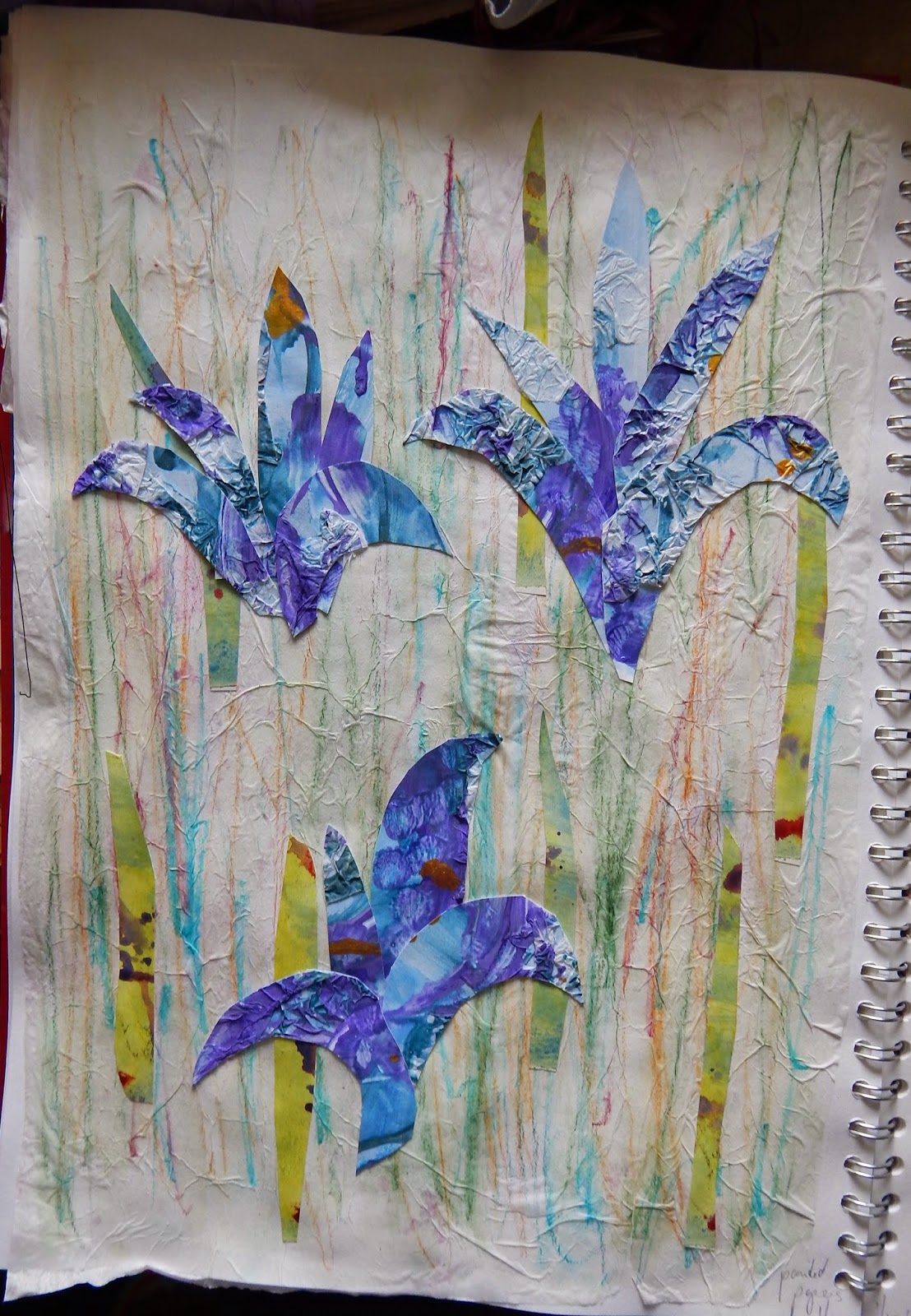This stage asks for a review of fabrics that we may use in projects, samples etc. I do not have a large table and far too many fabric pieces to be able to show here, so I have narrowed this illustration to three colour themes. There are a multitude of textures, tweed, felt, satiny fabrics, cottons and linens in different weights, silks, printed pieces, jerseys and pieces/sections of metallic effect fabrics.
There are also yarns in similar materials, woolly tweedy yarns - strong and weak, fluffy or smooth - silky silks and synthetics, strong linens thick and thin, paper yarn, sewing and embroidery threads, ribbon, homemade cords, basically all manner of things that can be used to stitch, knot, wrap, weave, loop and so on.
Blues - vintage cotton thread I dyed, grey alpaca wool, sewing threads, herringbone wool fabric, felt, knitted cotton thread, printed grey furnishing fabric.
Greens and reds - and old tie, pink linen thread and thin cotton, red silk, purple mohair, green paper yarn, silk, green-brown felt and acetate, some greeny-brown tweed.
Yellow, whites, oranges and brown - hessian, silk and silk paper, linens, synthetics sewing thread and wool.
So there is plenty of materials to draw on. There is plenty to think about when designing as well: for layering, texturing, scrunching, smoothing out. The key challenge is to think about designs and purpose of the work.
Stage 2 Developing ideas
This part asks us to continue designing. The suggestion is to select six images and work them up using the process introduced in the previous assignment. I have started this by turning to some photographs I took at different times - winter snow, a wooden door - and worked up an image of feathers. As the next step asks for samples in applique I think the lines of the drifting snow would be good to trace using layered fabric and stitch, or cutting out feather shapes in fabric and creating a collage of appliqued feather shapes.
Blue feathers in coloured pencil and watered down inktense.
Blue feathers in scratched-into blue-green oil pastels. This was a bit 'thin' for design purposes, a bit too subtle. I am not sure the pattern shows up very well here.
Green feathers in inktense and water soluble pencil - watered down and mixed, greens and yellows.
More feathers in a collagy composition
Here's a sample from stage 3 (left) - appliqued fabric, some elements just placed, a few bonded with bondaweb and all stitched to suggest the leaf outlines (silks, acetate and nylon organza)
The original photograph of subtle snow drifting areas, some blue, a bit of brown, white and greys.
Abstracting the snow picture using a blueish background in thinned out inktense with layers of tissue paper. This no longer looks like snow, but is interesting, I quite like this.

I am putting the sample here for reference - we were asked to play with fabrics, layering etc to get a feel for a selected sample. In the end I made two - this one in organzas, poly-cotton and a synthetic wadding that suggested snow:
A door in the old part of Stockholm suggests layering and relief, could be used to think about thick sections of fabric and quilting:
A variation in different colours and to a different scale:
Here's the source picture and another variation. When I came to do a detail I got some proportions and dimensions wrong, but it kind of could still be used, need not look like the original source. It is a bit of a distraction to have the source photo on the same page spread as the detail drawing.
Painted tissue paper glued as background, prepared papers in shapes.
Scrunched-up tissue paper, silk fabric, inktense scribbles
Glued-on tissue paper, paint, string painted
Collages using seeds and imitating these in paper:
Round shapes in tissue paper and plastic from a carrier bag, shell and whiteish paint mixed with PVA
The course material asks us to select 6 pictures. I think some of the above, would be useful. I like some of the snow pictures, the feathers, the door in pastel colours and some of the collages, especially the one with round shapes.






















No comments:
Post a Comment